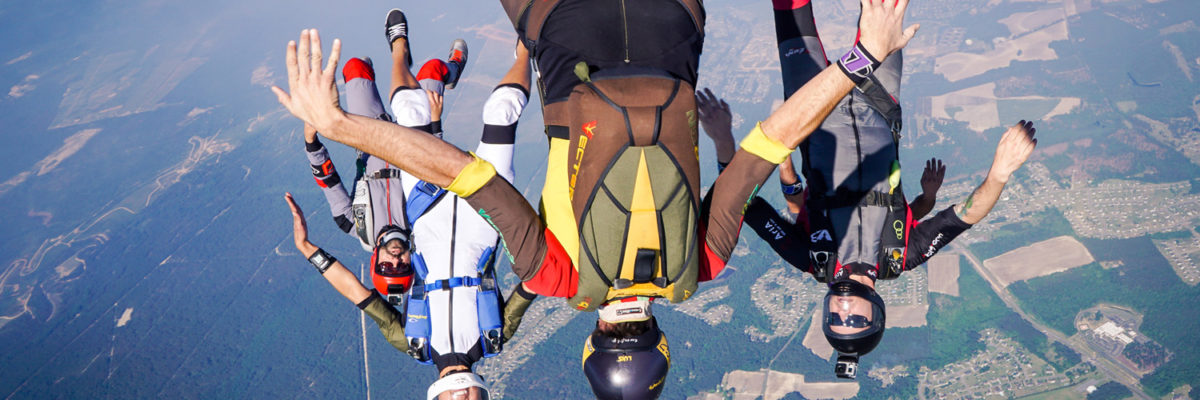
Terminal Velocity Skydiving
Wednesday, July 19, 2023
- Team FlyXP
- 7/19/23
- 0
- General, Skydiving
Let’s start here: don’t conduct any tests on the terminal velocity of a cat. Just don’t. With that aside, let’s tackle an interesting subject – terminal velocity – from a rather feline perspective.
As you might know, cats – naturally arboreal animals, built to spend their time in trees – had to evolve to, well, fall. Whether it’s a missed jump, a broken tree limb, or a gust of wind, sooner or later these slinky little acrobats are bound to take a tumble … which leads to their rather unique experience of terminal velocity.
As opposed to the terminal velocity of a rock, for instance, or the terminal velocity of a car, a cat’s terminal velocity is downright slothful. One key factor here is a cat’s body proportions. Cats have a relatively large surface area compared to their weight, which means that – when they have a whoopsie – they are able to expose a lot of surface area to slow themselves down.
In fact, according to a study by veterinarians Wayne Whitney and Cheryl Mehlhaff back in 1987, an average-sized cat with its limbs extended achieves a terminal velocity of about 60 mph. Meanwhile, an average-sized man hits a terminal velocity of around 120 mph.
Cool, huh? But … why?

What Exactly Does “Terminal Velocity” Mean?
Terminal velocity is not just a scientific concept – it’s a fundamental principle that anyone but, y’know, mostly skydivers – must understand. From comprehending the meaning of terminal velocity to actually experiencing the sensation of reaching it, let’s dig into your questions and provide insights into the transformative power of skydiving.
Terminal velocity refers to the maximum speed an object can reach when moving through a medium, such as air or liquid. It occurs “when the force of gravity is balanced by the resistance of the medium,” in scientific parlance. For skydivers, terminal velocity is the downward speed through the resistance of the air (“the medium”) achievable during freefall. When we exit an aircraft, our bodies accelerate until air resistance equals the force of gravity, leading to a constant speed of descent.
What does it feel like to reach terminal velocity? Like, can you breathe while falling at terminal velocity? Yep! You sure can breathe at terminal velocity. (In fact, you’ll probably be hollering with delight, an activity for which breathing is totally necessary!) Reaching terminal velocity during a skydive is an exhilarating experience. It’s the point where gravity and resistance find equilibrium, resulting in a feeling of floating rather than falling.
The transition to terminal velocity typically takes around 5 to 10 seconds during a skydive. However, despite the incredible speeds, skydivers don’t generally feel that whopping velocity due to the balance achieved between gravity and drag. In fact, it feels – and we know this is hard to believe before you experience it yourself – kinda peaceful.
Terminal Velocity, Human
What happens to a human at terminal velocity has everything to do with that human’s orientation in the sky and their presented surface area to the wind. By changing body positions, skydivers can alter their terminal velocity.
While the standard belly-to-earth position results in a terminal velocity of around 120 mph, the terminal velocity of a human flying headfirst can increase the speed to 150-180 mph, and potentially reach 200 mph! (Comparatively, a peregrine falcon holds the title for the fastest member of the animal kingdom, reaching speeds of 242 mph during hunting!)
Tandem skydivers, who have double the weight and additional gear, experience a terminal velocity of around 120 mph.
Skydiving Disciplines
The position skydivers take in freefall has a lot to do with what they’re trying to achieve up there … so let’s talk about skydiving’s many disciplines.
Different skydiving disciplines showcase the varying terminal velocities achievable by skilled skydivers. In speed skydiving, competitors aim to attain and maintain the highest possible terminal velocity. By reducing friction and maintaining a streamlined head-down position, speed skydivers can reach incredible speeds, making it one of the fastest non-motorized sports on Earth.
Wingsuit flying takes a different approach, as it aims to convert downward speed into forward speed. Wingsuits incorporate ram-air airfoils, which pressurize similarly to parachutes, allowing pilots to fly using the principles of aerodynamics. With wingsuits, skydivers experience a drop in terminal velocity while soaring through the air at high speeds.
Calculating Terminal Velocity
Terminal velocity can be calculated by considering multiple factors, including the shape of the falling/flying object (i.e. body position in freefall or yes:no wingsuit status), total weight (body and gear combined), and air density.
Curious? Here’s a terminal velocity calculator to play around with.
That said, calculating terminal velocity means nothing until you’ve reached terminal velocity! So go ahead and book your tandem skydive today, you super-cool scientist, you! Blue skies.
Copyright © 2025, Skydive Paraclete XP, All Rights Reserved.
DropZone Web Design & Marketing by Beyond Marketing, LLC

